Eels are honestly weird. Their long, snake-like bodies and mouths full of fangs make a lot of people wary of them. In truth, eels are a vital part of a healthy aquatic ecosystem.
They usually have no scales, have long cylindrical bodies, and some even have an extra set of jaws in their mouths. You can find eels in almost every body of water around the world, from rivers and lakes to coral reefs and the deep ocean.
Among animals, eels are a fascinating group. In this article, we’ll discuss some basic information about eels, the 19 types of eels, and why they’re so popular as a food item.
All About The Different Kinds of Eels Species
Eel Scientific Classification
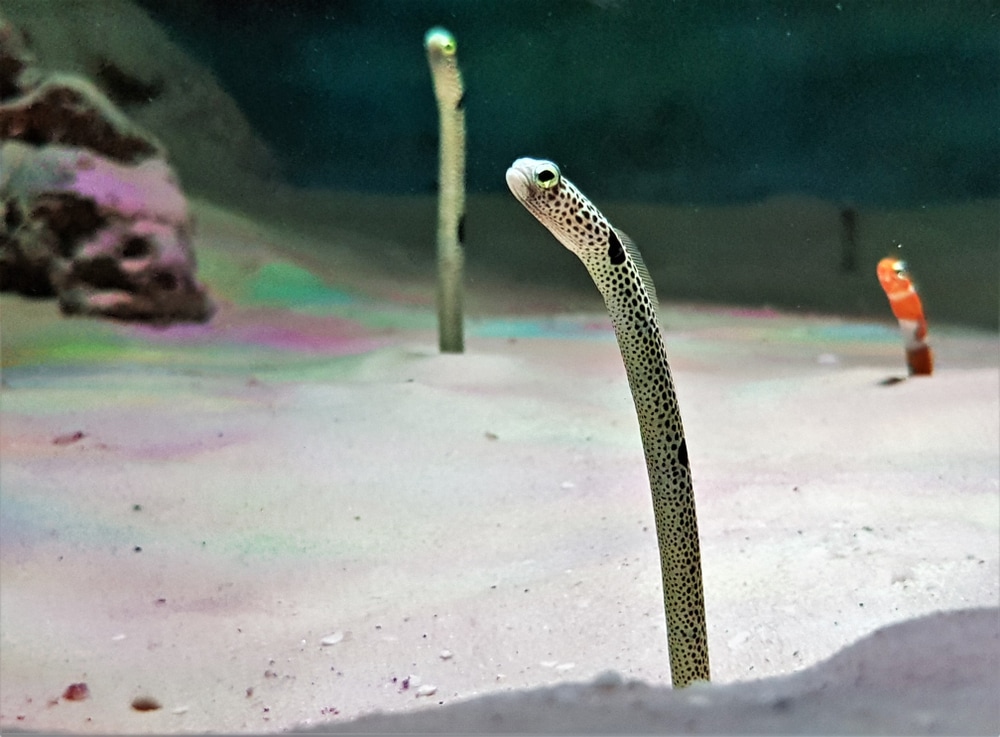
Eels belong to the scientific order of Anguilliformes. Anguilliformes are made up of eight suborders, 19 families, 111 genera, and over 800 individual species. To put it simply, eels are incredibly diverse and there are a lot of them.
Eel Description
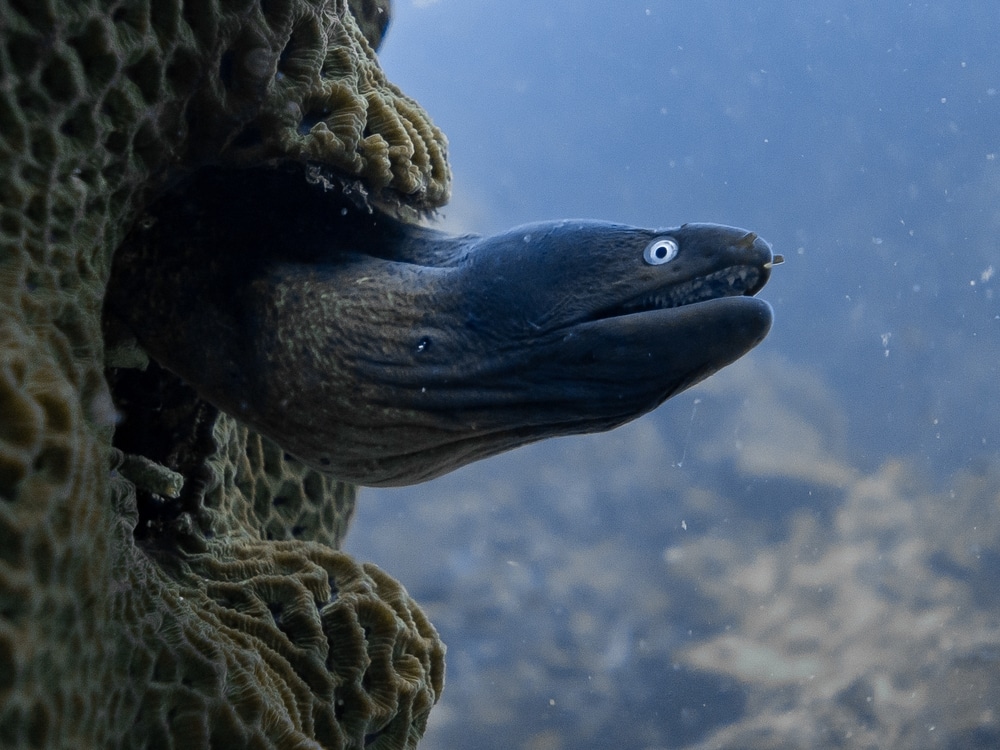
Eels are a type of bony fish, distinguished by their long, snake-like bodies. They typically only have pectoral fins and any dorsal or anal fins are joined with the caudal fin to form a ribbon-like structure along the body.
Unlike most fish, eels don’t have scales. Instead, their skin is covered with a protective mucus layer that can even hold water, allowing them to breathe on dry land for up to a few hours.
Different species of eels have different sizes, color patterns, habits, diets, and habitats. The largest eels can grow to over thirteen feet in length and weigh over 250 pounds (113 kg). The smallest eels weigh a single ounce and are only a couple of inches long.
Eels move through the water by undulating their bodies in a wave pattern. To swim backward, they simply reverse this motion.
One of the most fascinating things about eels is that morays have pharyngeal jaws. This is an extra set of jaws that sit further back in the throat, and are pushed forward to grab and pull down anything the main jaws have latched onto.
While many fish have these, morays are special in that their extra jaws can move much farther than is typical. Eels have sharp, backward-facing, needle-like teeth that sink in and hold onto prey. Their extra jaws allow them to transport and swallow that prey without needing to have hands or paws.
Feeding Habits and Behavior of Eels

In general, eels live rather sedentary lives. As nocturnal animals, they spend most of the day inside their hidey-hole. At night, they hunt. Eels vary in hunting behavior depending on the species, with some acting as ambush predators and others actively chasing down prey.
Many species have been documented hunting in packs, and even asking eels of other species to form hunting parties with them. Eels have even been documented to hunt with other species like grouper.
The bulk of a saltwater eel’s diet is made up of fish, crustaceans, invertebrates, and other eels. Freshwater eels have similar diets, feeding on fish, crayfish, worms, smaller eels, and insect larvae.
Some eel species prefer to be solitary creatures, especially in their adult stages. Others congregate in groups numbering in the hundreds.
Eel Life Cycle
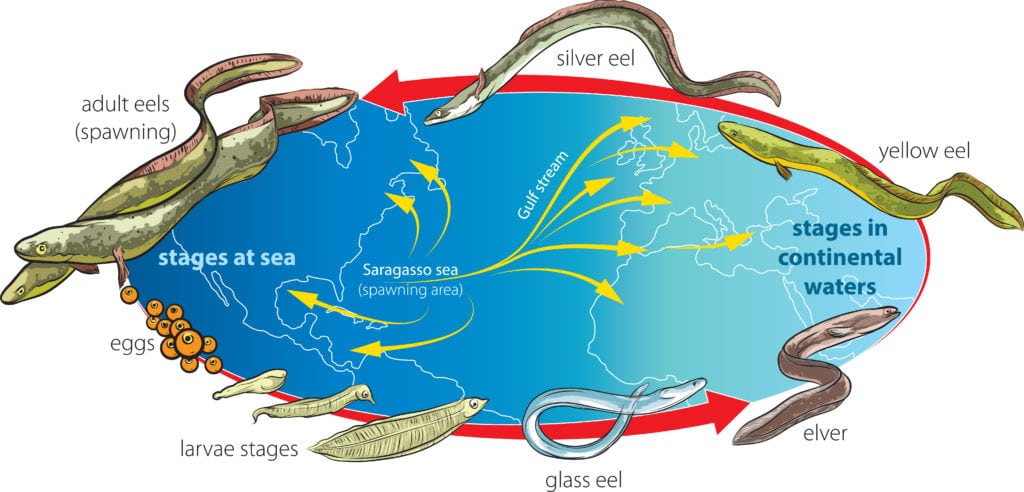
All species of eel go through four life stages: The larval stage, glass eel stage, elver stage, and adult stage.
During the larval stage or leptocephali stage, the eels drift around the water column as flat, transparent creatures. They mostly feed on marine snow and plankton=sized creatures until they grow enough to reach the glass eel stage.
In the glass eel stage, they begin to eat larger prey items relative to their size and move to river mouths and estuaries to continue growing.
When eels reach their elver stage, they begin to move to their adult habitats. This is the final stage before the eels become fully grown adults. Freshwater eels begin moving upstream in search of lower salinities and saltwater species move further out to sea.
Adult eels continue to grow and mature until they reach sexual maturity, a process whose time frame depends on the species of eel. Once they reach maturity, they travel from their homes to spawning grounds to reproduce and then die.
Eel Reproduction
The process of how eels reproduce is still relatively unknown. Many eels only mate and reproduce in their final life stages, and die afterward. What is known is that they go through four main stages in their lives, from larvae to adults, and there are specific eel breeding grounds located throughout the world.
Range
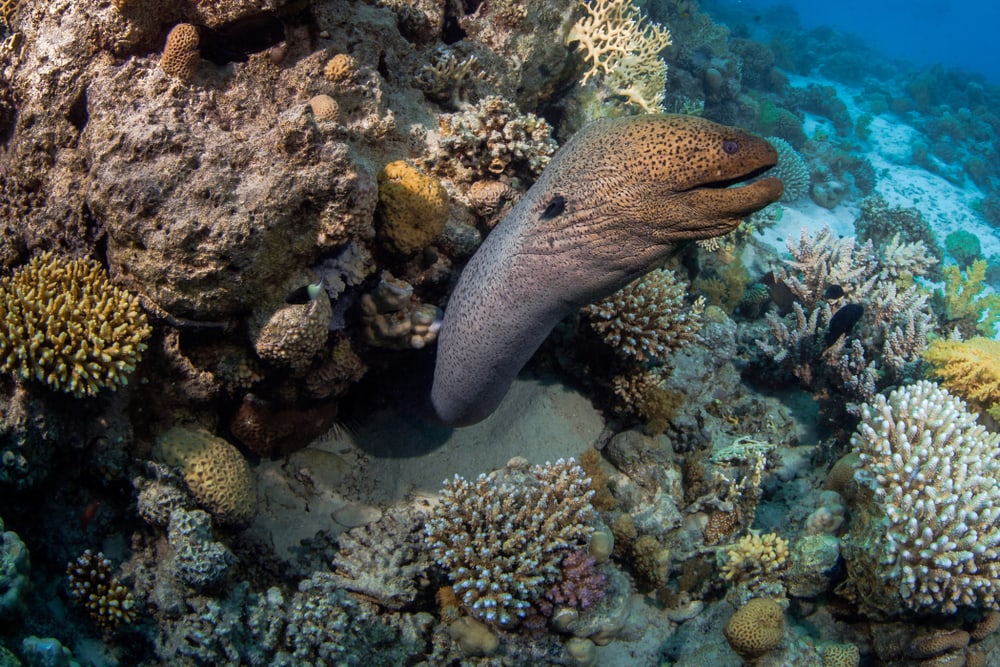
You can find eels in both freshwater and saltwater, though most species live in saltwater. Eels are found worldwide, on every continent except for Antarctica.
You may also like: Learn Where Your Water is Coming From with this 47 Different Bodies of Water: Complete with Images, Facts, and More!
19 Main Types of Eels
There are over 800 distinct species of eel scattered around the world. The easiest way to break them down is with the 19 families each of these species fit into and are scientifically categorized by.
Here, we’ll discuss each family of eels, their distinct characteristics, and give examples of specific species within the family.
1. Anguillidae (Freshwater eels)
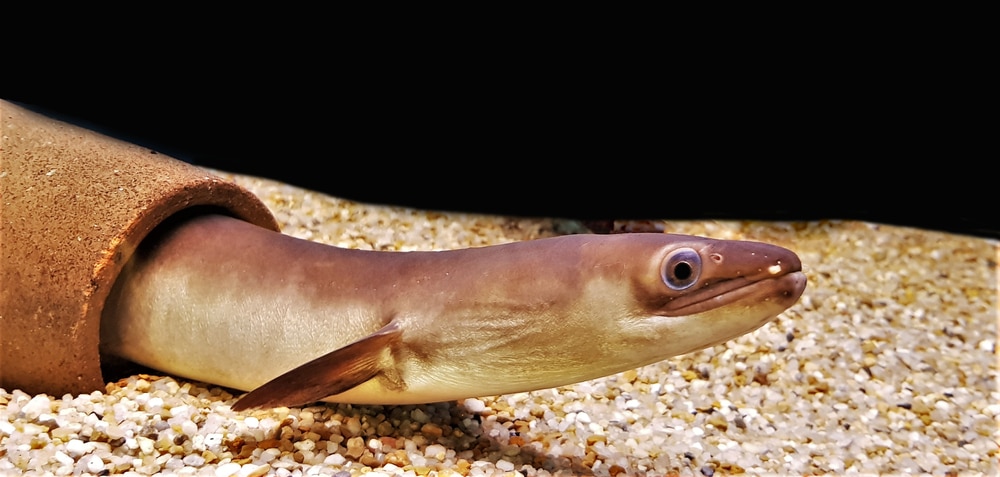
Freshwater eels are considered catadromous, meaning they live in freshwater but return to oceans to spawn. Many young freshwater eels stay in estuaries and river mouths (in saltwater) as they mature, returning to rivers in adulthood.
Typically, these eels reach sexual maturity at around 15 years old. When this occurs, they exit the rivers and move to specific ocean breeding grounds to spawn, likely dying shortly afterward.
Only one species of freshwater eel is native to North America, the American eel. Their spawning ground is in the Sargasso Sea, off the coast of Bermuda. Adult female eels can grow up to four feet (1.21m) in length, while males typically only reach one and a half feet (0.45m).
Other freshwater eel species include:
- European Eel – (Anguilla Anguilla)
- Short-finned Eel – (Anguilla Australis)
- Indian Mottled Eel – (Anguilla Bengalensis)
- Indonesian Shortfin Eel – (Anguilla Bicolor)
- Indonesian Longfin Eel – (Anguilla Borneensis)
- Celebes Longfin Eel – (Anguilla Celebesensis)
- New Zealand Longfin Eel – (Anguilla Dieffenbachii)
- Highlands Long-finned Eel – (Anguilla Interioris)
2. Chlopsidae (False morays)
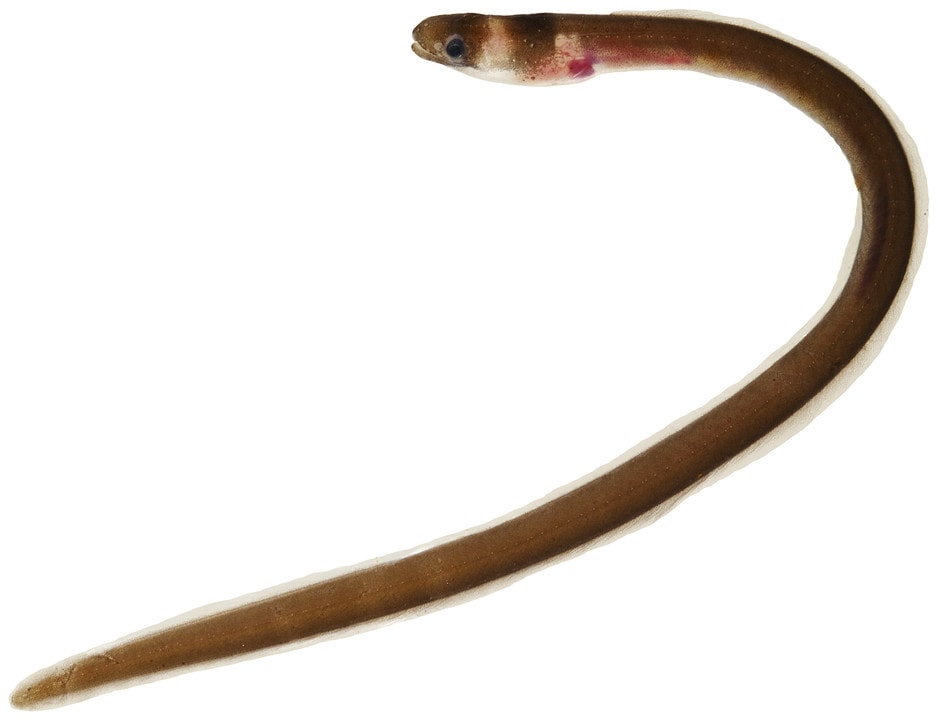
(CC BY 2.5)/wikimiedia commons
False morays are essentially a mini version of their larger cousins. Most specimens only reach around 7 to 8 inches (17.78 cm to 20.32 cm) in length.
They’re a tropical and subtropical group, mostly found on coral reefs. They’re not easily found, as they tend to bury themselves in the sand or hole up in crevices between rocks. Like most eels, they live a pretty sedentary life, waiting for an opportune moment for prey to wander too close to their hiding spot.
Many species of false moray can be found around North and Central America.
Other species of false morays include:
- False Moray Eel – (Catesbya pseudomuraena)
- Seagrass Eel – (Chilorhinus suensonii)
- Stripesnout False Moray – (Chlopsis apterus)
- Bicolor False Moray – Chlopsis bicollaris)
- Mottled False Moray – (Chlopsis dentatus)
- Kazuko’s False Moray – (Chlopsis kazuko)
- Plain False Moray – (Kaupichthys hyoproroides)
- Collared Eel – (Kaupichthys nuchalis)
- Shortfin False Moray – (Kaupichthys brachychiru)
3. Colocongridae (Short-tail eels)
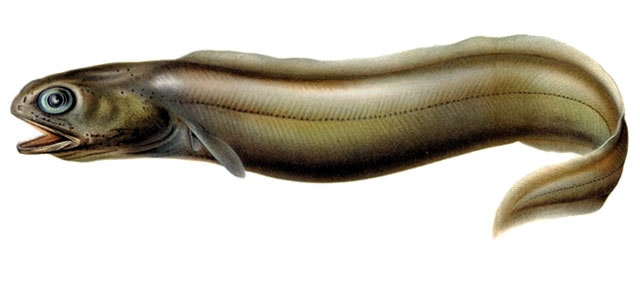
Short-tail eels have shorter, stubbier bodies than other eel families. The blunt-snouted eel prefers warm water but prefers the deep, typically living between 1,000 to 2,900 feet (304.8 m to 883.92 cm) down.
Species of short-tail eels are found off the coast of North America, South America, Africa, and Australia.
Species of short-tail eels include:
- Giant Leptocephalus – (Coloconger giganteus)
- Froghead Eel – (Coloconger raniceps)
- Indo-Pacific Short-tail Conger – (Coloconger scholesi)
4. Congridae (Conger eels)
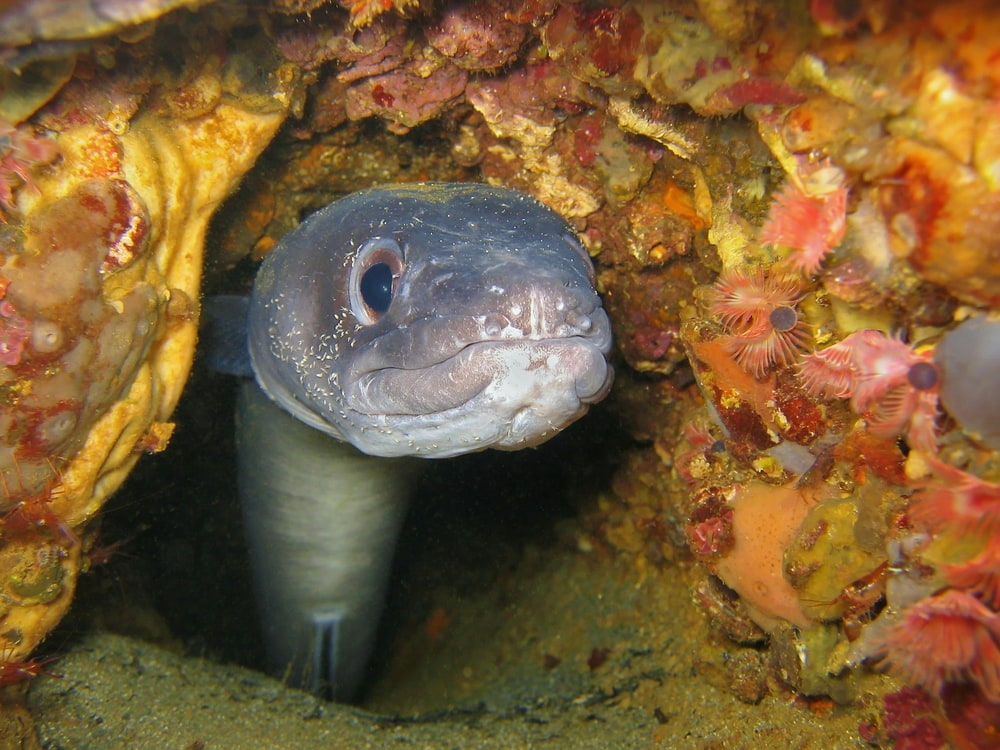
Conger eels are unlike other eels in that they typically don’t migrate far to spawn. They have large heads, wide mouths, and can be found down to depths of 2,900 feet (883.92 m). The 194 species that are in the family are spread out across the world, residing in the Atlantic, Indian, and West Pacific Oceans.
The European Conger is the heaviest eel we know about. They can grow to be around ten feet in length (3.048 m) and some specimens have been found to weigh over 200 pounds (90.71 kg).
Garden eels are smaller eels that also fit into the conger family. They live in colonies on the sandy bottom and look like patches of seagrass when they all extend from their burrows.
Species of conger eels include:
- European Conger – (Conger conger)
- Splendid Garden Eel – (Gorgasia preclara)
- Gray Conger – (Conger esculentus)
- Threadtail Conger – (Uroconger syringinus)
- American Conger – (Conger oceanicus)
- Longfin African Conger – (Conger cinereus)
5. Derichthyidae (Longneck eels)
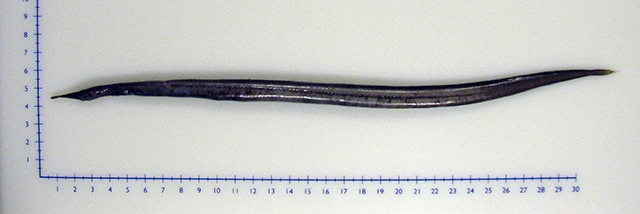
Longneck eels are one of the only families to live in the open ocean. The pelagic family only has three species in it, all of which grow to between one and two feet in length (0.30 and 0.60 m).
Adult eels of these species have striped heads and the stripes are part of their sensory system. Since they live away from the bottom and in the middle of nowhere, they use special senses to help them find food and avoid predators.
Species of longneck eels include:
- Narrownecked Oceanic Eel – (Derichthys serpentinus)
- Dana Duckbill Eel – (Nessorhamphus danae)
- Duckbill Oceanic Eel – (Nessorhamphus ingolfianus)
6. Heterenchelyidae (Mud eels)

The eight species of mud eel can be found in the Atlantic, Mediterranean, and Eastern Pacific Oceans. They’re specially adapted for burrowing into soft muddy bottoms.
The family has no pectoral fins, no scales, and a large mouth for snapping up prey. Typically, they grow to between 13 and 60 inches (2.54 cm and 152.4 cm) in length.
Species of mud eel include:
- Pacific Mud Eel – (Pythonichthys asodes)
- Caribbean Mud Eel – (Pythonichthys sanguineus)
- Slender Shortfaced Eel – (Panturichthys longus)
- Mauritanian Shortface Eel – (Panturichthys mauritanicus)
7. Moringuidae (Spaghetti eels, Worm eels)
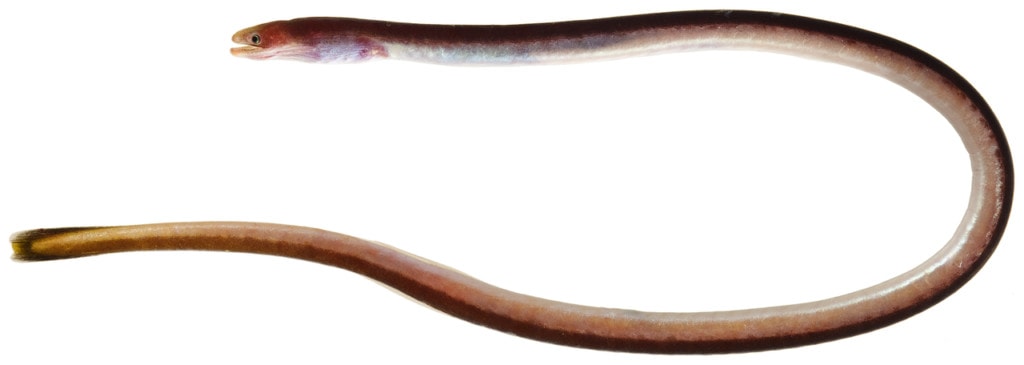
(CC BY 2.5)/Wikimedia commons
Spaghetti eels get their name from their long, thin, noodle-like bodies. They can be as short as five inches (12.7 cm) or as long as 55 inches (139.7 cm) in length.
You’ll typically find them in the tropical areas of the Indian, Pacific, and Atlantic Oceans, but sometimes you can find them in fresh water as well. The purple spaghetti eel can be found in rivers and estuaries from Indian to the Philippines.
Species of spaghetti eels include:
- Purple Spaghetti Eel – (Moringua raitaborua)
- Bengal Spaghetti Eel – (Moringua arundinacea)
- Swollengut Worm Eel – (Neoconger tuberculatus)
- Smalleye Spaghetti-eel – (Neoconger vermiformis)
8. Muraenesocidae (Pike conger eels)
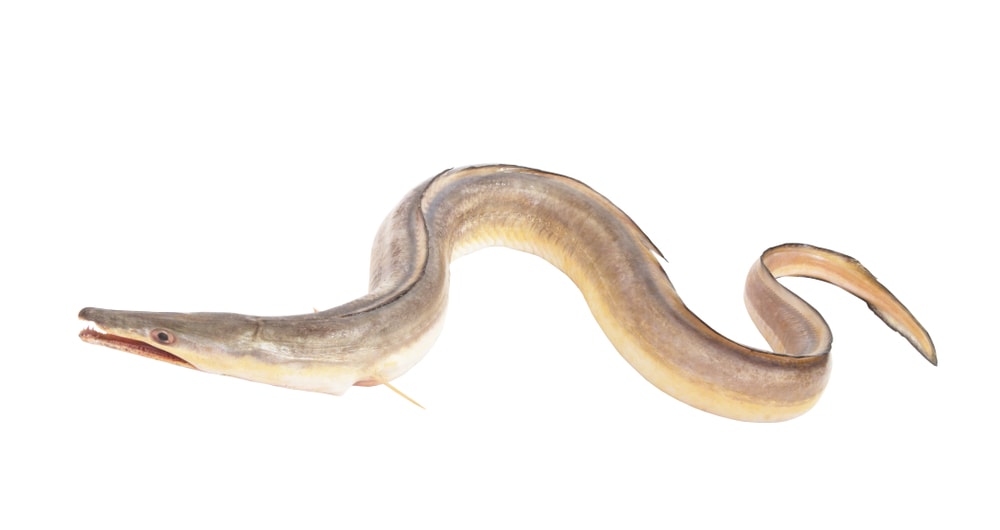
Pike conger eels are large eels that can move between freshwater and saltwater, though they tend towards saltwater. Specimens grow from two to eight feet (0.60 m to 2.43 m) in length and can be found as deep as 800 meters (2624.67 ft). There are around fifteen species of pike conger found around the world.
The daggertooth pike conger averages around five feet (1.52 m) in length and can be found in the Red Sea, Indian Ocean, and the Pacific Ocean around Japan. They’ve also entered the Mediterranean thanks to the building of the Suez Canal.
Daggertooth is a big commercial species of eel, caught and eaten in China, Japan, and Taiwan.
Species of pike conger eels include:
- Daggertooth Pike-conger – (Muraenesox cinereus)
- Common Pike-conger – (Muraenesox bagio)
- Duckbill Conger – (Gavialiceps javanicus)
- Red pike-conger – (Cynoponticus coniceps)
9. Muraenidae (Moray eels)
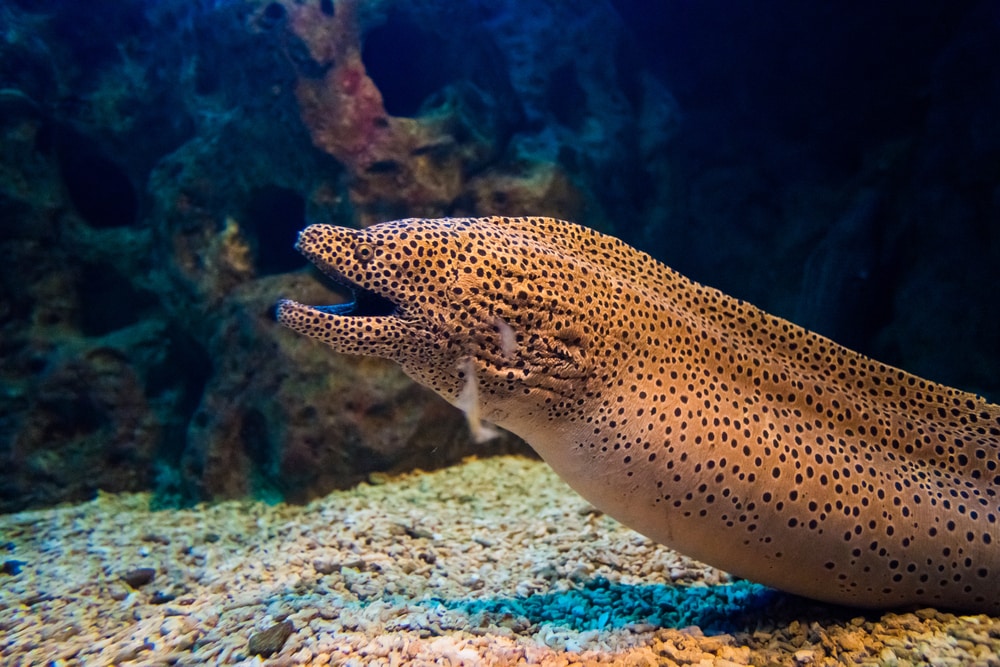
With nearly 200 species filling the family when you think of eels you likely think of some kind of moray eel. Moray species are typically shallow water eels, and range in size from four and a half inches (11.43 cm) up to thirteen feet (3.96 m) in length.
Many species of moray eel have spectacular patterns or brightly colored skin, making them a favorite for aquariums. They’re one of the most common eels to bite humans too, especially when larger species are provoked.
The giant moray is the largest moray eel in terms of body mass, reaching over ten feet (3.04 m) in length and a weight of up to 65 pounds (29.48 kg). The smallest moray eel is the Snyder’s eel which only gets to around 4.5 inches (11.43 cm) in length.
Species of moray eels include:
- Ribbon Moray – (Rhinomuraena quaesita)
- Giant Moray – (Gymnothorax javanicus)
- Zebra Moray – (Gymnomuraena zebra)
- Black Moray – (Muraena augusti)
10. Myrocongridae (Red eels)

Not a lot is known about red eels. As recently as 1990, there was only one known species in the family, and today only four more have been found.
Very few of these creatures have been caught or examined, resulting in the fact that while we know they exist, we know almost nothing about their habitat, behaviors, or lives.
The red eel species has only three known specimens that were found off the coast of Africa.
Species of Red Eels include:
- Red Eel – (Myroconger compressus)
- Myroconger gracilis
- Orange Conger-Moray – (Myroconger nigrodentatus)
- Myroconger prolixus
- Myroconger seychellensis
11. Nemichthyidae (Snipe eels)
_Nemichthys_scolopaceus.jpg)
Another pelagic species, snipe eels are typically found at depths ranging from 1,000 to 2,000 feet (304.8 m to 609.6 m). All nine species of snipe eels have exceptionally slender and tubular bodies and grow to lengths between three and five feet (0.91 m and 1.52 m)
The defining feature of snipe eels is their jaws. They’re long and slender. The ends of their jaws curve away from each other, similar to the wading birds they get their name from.
Species of snipe eels include:
- Southern Snipe Eel – (Avocettina acuticeps)
- Slender Snipe Eel – (Nemichthys scolopaceus)
- Boxer Snipe Eel – (Nemichthys curvirostris)
- Avocet Snipe Eel – (Avocettina infans)
12. Nettastomatidae (Duckbill eels)
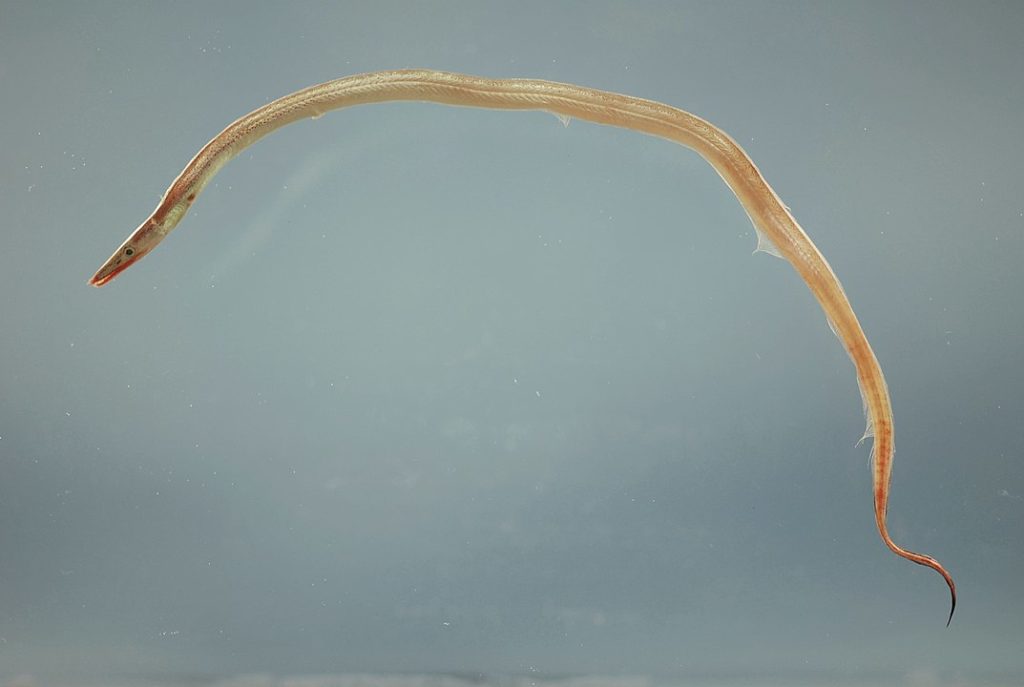
Duckbill eels are frequently found along the continental shelves in the Atlantic, Indian, and Pacific Oceans. Typically, the species of the family spend their time on the bottom and grow to around four feet in length.
They have slender heads, most don’t have pectoral fins, and almost all of them are some form of gray. 42 species make up the duckbill eel family.
They get their name from their duckbill-shaped mouths and are common prey for deepwater species like codfish.
Species of duckbill eel include:
- Blackfin Sorcerer – (Nettastoma melanurum)
- Whipsnout Sorcerer – (Venefica proboscidea)
- Freckled Pike-conger – (Hoplunnis macrura)
- Pygmy Duckbill Eel – (Nettenchelys pygmaea)
13. Ophichthidae (Snake eels)
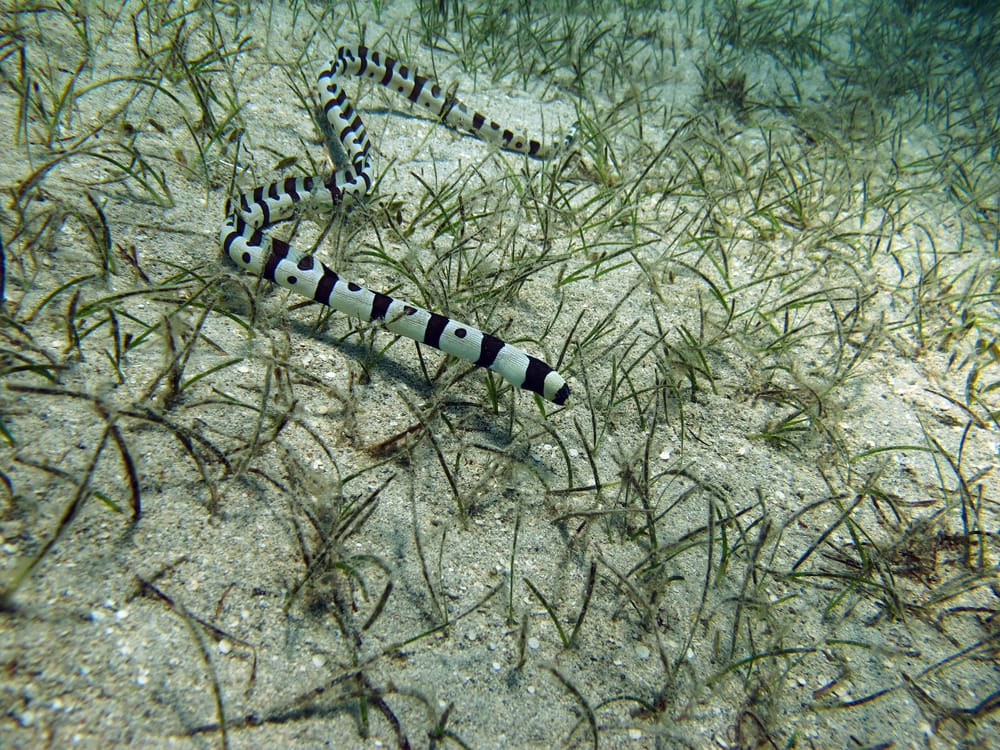
Snake eels are the eel species that most closely resemble snakes in their appearance. They inhabit a wide range of habitats, from rivers to ocean depths of 2,600 feet (792.48 m). Snake eels range in size from two inches to over seven feet in length.
Almost all snake eels lack fins, which helps them dig and burrow through sand and mud like worms. Many of them have colors and markings that look like venomous sea snakes to help scare off predators.
Species of snake eel include:
- King snake eel – (Ophichthus rex)
- African spoon-nose eel – (Mystriophis rostellatus)
- Rice-paddy eel – (Pisodonophis boro)
- Margined snake eel – (Ophichthus cruentifer)
14. Serrivomeridae (Sawtooth eels)

Sawtooth eels are deepwater, pelagic eels. They have inward-facing teeth that resemble a saw, giving them their name. There are around eleven species in this family.
Most species in this family reach a maximum length between 60 to 70 centimeters (23.6 inches to 177.8 inches).
Species of sawtooth eels include:
- Samoan sawtooth eel – (Serrivomer samoensis)
- Black sawtooth eel – (Serrivomer brevidentatus)
- Crossthroat sawpalate – (Serrivomer jesperseni)
15. Synaphobranchidae (Cutthroat eels)
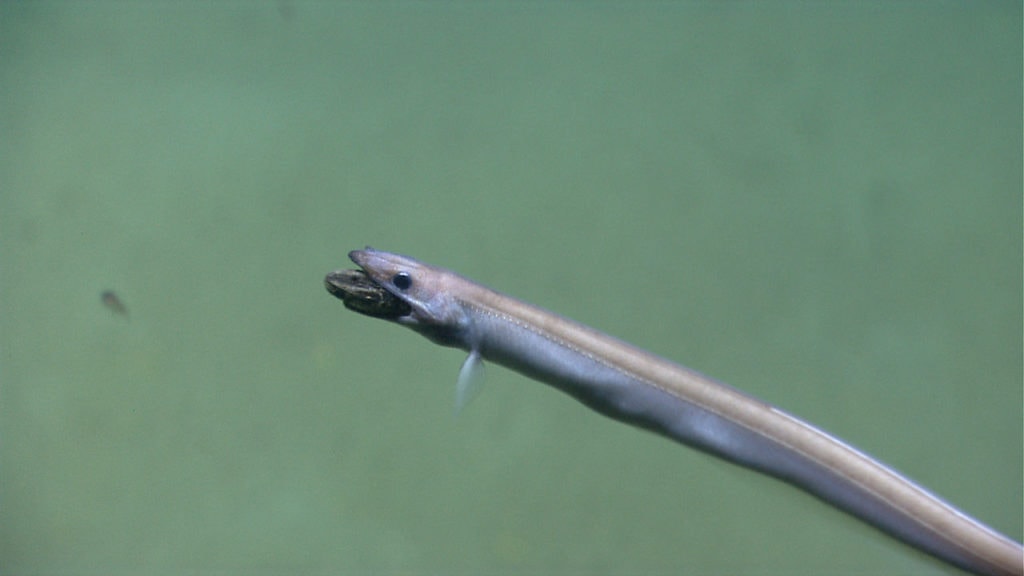
Cutthroat eels are a super-deepwater species of eel that are typically found up to 12,000 feet (3,657.6 m). The species in this family range from 9 to 63 inches (22.86 to 160.02) in length.
Cutthroat eels get their names from the way their gills are situated on their throats. They’re very low, almost underneath the animal, resulting in the eel looking like it has a slit throat.
The classification of this family is up for debate, where some place species like the snub-nosed eel in their own sub-family.
Species of cutthroat eels include:
- Shortdorsal cutthroat eel – (Synaphobranchus brevidorsalis)
- snub-nosed eel (Simenchelys parasitica)
16. Protanguilla (First Eels)
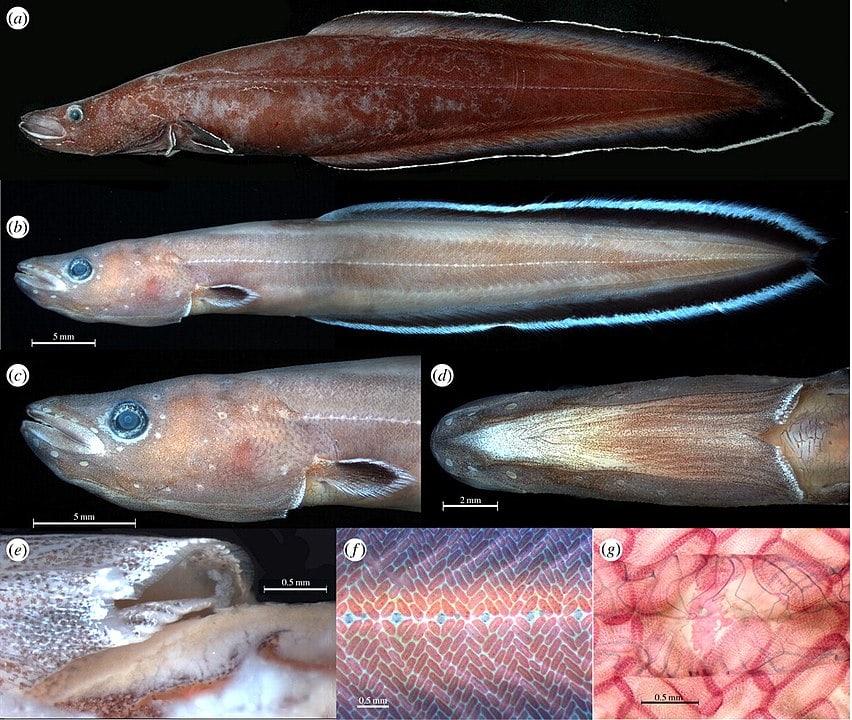
wikimedia commons
Protanguilla is a fascinating family of eels consisting of only a single species. In March of 2010, these eels were found swimming in a deep underwater cave.
The rather small eels, up to seven inches (17.78 cm) in length, are called first eels due to their relatively primitive features. While it sounds crude, it simply means that the eels have features (like bony gill rakers) that appeared farther back on the evolutionary chain than other species of eel we see today.
They likely remained undisturbed in cave systems for millennia, resulting in them surviving until the present as what we could call a living fossil.
17. Eurypharyngidae (Pelican eels)
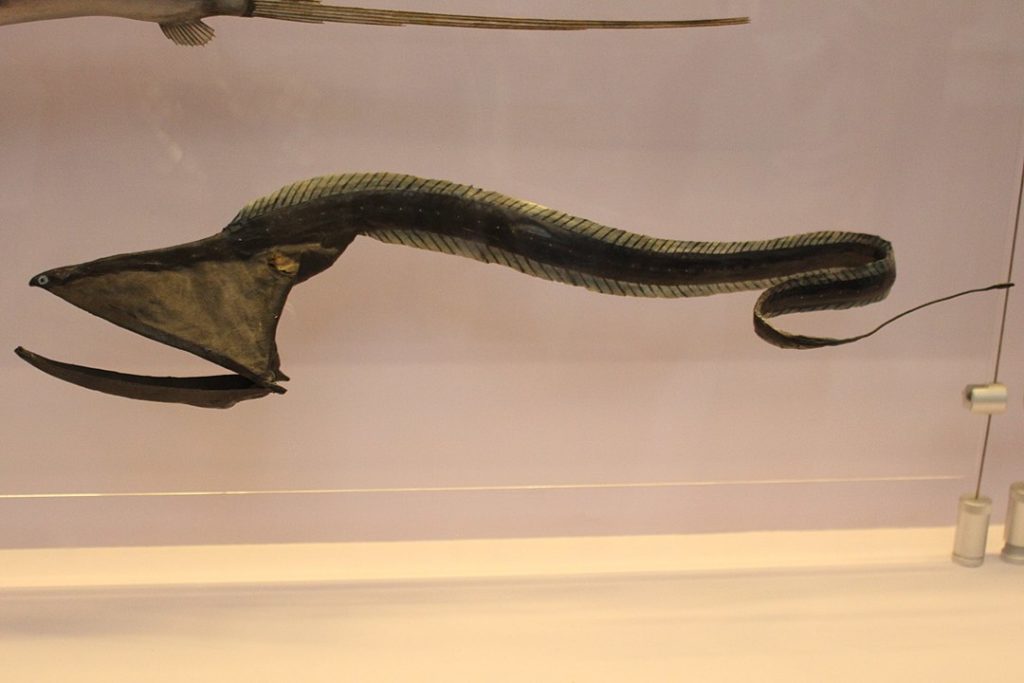
Gulper eels are rarely seen by people thanks to their natural habitat being the super-deep areas of the ocean. They’re only rarely seen when deepsea trawling nets bring them up to the surface.
As it stands, only one species of gulper eel has been confirmed to exist. Like other deep-sea fish (see blobfish), gulper eels have bodies that change shape when they’re brought to the surface and no longer have the immense pressure of the depths pushing on them.
Because of this, it’s hard to determine exactly what they look like in their native environment. What we can be sure of is that they have a massive mouth with a pouch like a pelican, a whip-like tail, and a complex organ on the end of its tail that emits flashes of light to attract prey in the pitch-black ocean depths.
18. Saccopharynx (Deepsea large-necked eels)

Also called gulper eels, these eels are another deepsea species that have a huge throat pouch instead of a huge mouth pouch.
Many of the same things ring true for Saccopharynx as Eurypharyngidae. They’re rarely seen, rarely observed, and we know almost nothing about them.
19. Monognathidae (One jaw gulpers)

Finally, another family of deep sea gulper eels. What makes these stand out as their own family is that they have more normally-proportioned mouths than the other families of gulper eels.
Like the others, moth of their body length is their tail, which tapers down the farther along it you go. You typically only find gulper eels of all families in deep water up to 10,000 (3,048 m) feet.
You may also like: Learn the 17 Types of Catfish You Can Find Across the Globe: Complete With Images, Facts, Descriptions, and More!
Electric Eels
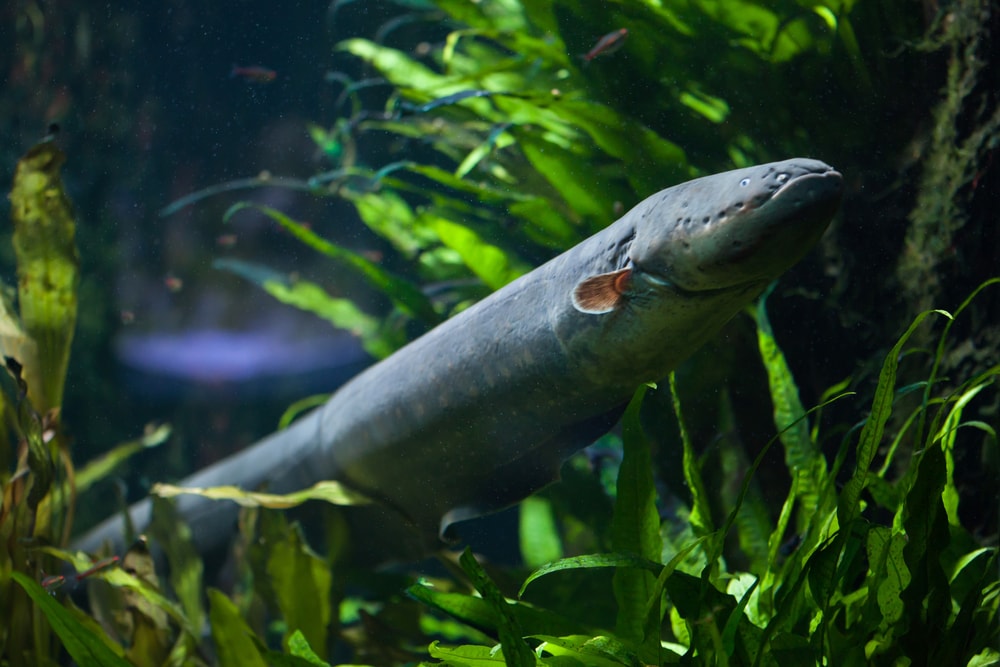
Electric eels are huge, growing up to nine feet in length and weighing in at up to fifty pounds. There are three species of electric eels, and all of them are native to South America.
The truth is, electric eels are not eels, but a type of knife fish. They evolved their eel-like shape independently of what we call true eels.
Electric eels prefer murky, slow-moving water. They’re almost blind, using their electric charges to sense both predator and prey in the water.
They frequently come to the surface to gulp air, and their mouth can act as a lung to provide them oxygen. This adaptation allows them to live in incredibly shallow and stagnant pools of water.
Electric eels are capable of producing shocks of up to 600 volts. They both use it to paralyze prey and protect themselves from predators. Their nervous system and body contain specialized organs that produce electrical charges. To put it incredibly simply, they create shocks by causing an imbalance between charges and expelling it.
These fish feed on anything they can, including fish, crustaceans, amphibians, and even fruits and nuts.
You may also like: How Do Electric Eels Work? All About The Fish That Will Shock You
Human Consumption Of Eels

Freshwater eels and conger eels are the most commonly eaten eels by humans. Eel was a staple food around the world for a long time in places like England, Japan, Korea, and China. Even today, humans consume millions of pounds of eel each year.
Consumption of eels has decreased over time due to protective measures put in place to try to stop the decimation of eel populations. Eels take a long time to reach full size, however, they are pretty easy to farm. This has resulted in an explosion in eel farming in recent years, as eel’s price per pound remains incredibly high.
Eel farming, while not difficult, is complicated. They only spawn in certain areas, so farmers can’t breed them the way they would tilapia. Young elver eels are netted in rivers and brought to facilities where they are then grown to a marketable size. Once big enough, the eels are processed and sold.
In the United States, eel has grown in popularity thanks to the increase in sushi consumption in recent years. Unagi, as freshwater eels are called in Japan, is a large part of the cuisine behind tuna.
Smoked eel is a popular delicacy in Germany, the Netherlands, the Czech Republic, Poland, Denmark, and Sweden.
Eels were a primary food in England along the River Thames as far as London. The first eel pie and mash houses opened in the 1700s.
You may also like: Learn the Different Species of Turtles in Florida: With Chart, Images, Facts, and More!
Sustainability and Outlook for Eels
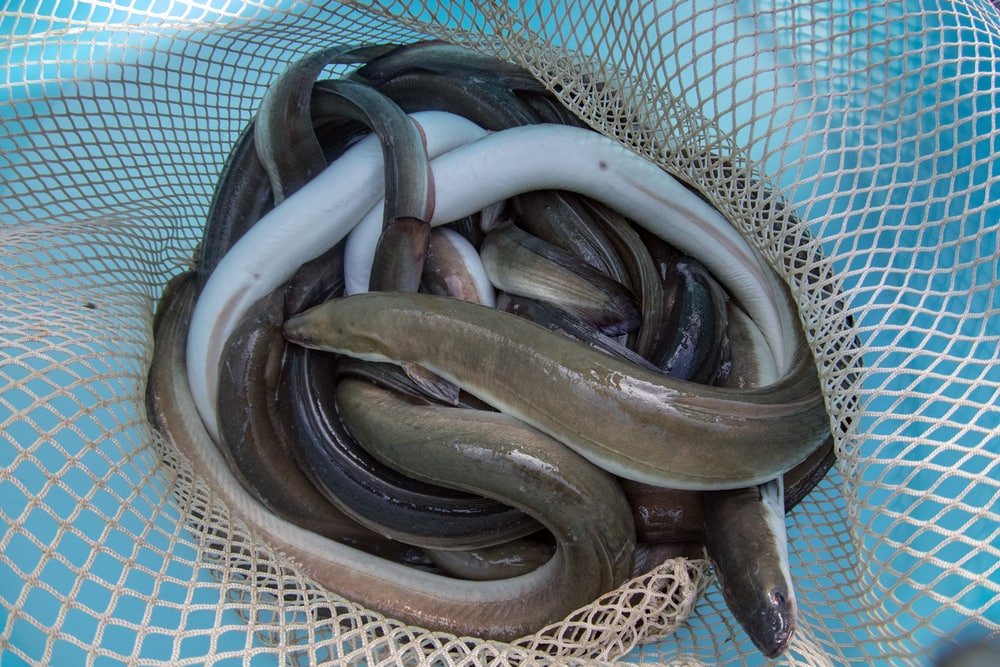
Eels are a rather hardy species, capable of changing environments and having a wide variety of prey species. Despite this, many populations of eels are threatened by human activities just like other fish species.
The biggest threats to eels include pollution, changes in the environment, overfishing, drainage, and hydro development. Overfishing has led to the decline in many eel populations that were once incredibly numerous.
Damming rivers has a major effect on eels. Many species must enter or exit rivers in order to spawn. Even many primarily saltwater species spend some time in brackish or freshwater. Dams and other obstructions block their way to feeding and spawning grounds, effectively killing them off.
Similar to salmon, many places where eel populations are known to migrate have installed “eel bridges” to help them navigate rivers.
Pollution and invasive bacteria, parasites, and disease also put eels under threat. European and North American populations suffer from the accidental introduction of Asian parasites.
Many of the prettier eel species are caught for the aquarium trade, and the over-capture of prime breeders results in a reduction of local populations.









